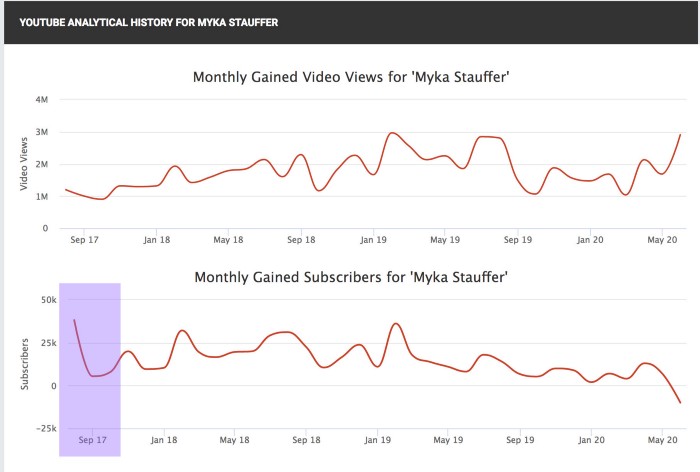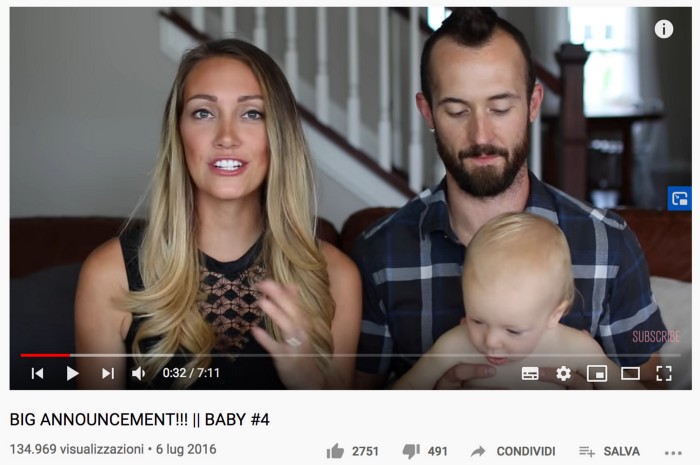Influencer marketing and children: the Myka Stauffer case

In the past few days, an American case has further deepened the reflection on influencer marketing and the role of children in this field. Let us see what happened and conduct a brief analysis of the data in this story.
Cover photo: Myka Stauffer e il marito James Stauffer
Why did the controversy erupt?
American YouTuber Myka Stauffer revealed in a video that she had "re-homed" her son Huxley, adopted about 3 years earlier, due to the child's behavioral problems, stemming from a severe form of autism.
Myka's audience had noticed Huxley's absence in the content published in recent weeks and reacted quite negatively to the news, with comments that, in the kindest versions, labeled Myka as a bad mother, a narcissist who treated her own child like a puppy returned because it couldn't fit into the influencer's perfect life.
Naturally, there was also a lot of concern for the child, who had to change families under his delicate medical conditions.
Some sources, however, point out that adoptions do not always end happily due to the traumas previously suffered by the children, and that this case is exposing a truth unknown to many, with the aggravating factor of social hating towards a family afflicted by enormous suffering. At the time of writing, Myka has deleted and closed comments on Instagram and removed one of her two YouTube channels.
Huxley's role in his mother's success
Huxley, along with Myka's other children, featured in online content through which the full-time YouTuber earns daily, both through platform monetization and brand collaborations.
The numerous users outraged by the Stauffer family's choice and various observations made by some American outlets and other YouTubers raise the suspicion that Huxley was adopted to give more momentum to his former adoptive mother's YouTube channel.
A gesture of generosity strategically planned without considering the child's difficulties, then? No one can tell if this hypothesis is true, but through the data, we can get an idea of the results Myka Stauffer achieved online with the arrival of little Huxley in the family.
Myka Stauffer is today a fairly well-known American YouTuber, her main channel has about 700,000 subscribers, and her videos showcase the family's life, including education, house cleaning, home design - a format we've also come to know in Italy.
Myka, along with her husband James, in 2016 chose to expand the family, already consisting of the couple and three other children, by welcoming a child with disabilities through an international adoption in China. Huxley arrived in the United States when he was less than 3 years old but had begun to be part of his adoptive mother's online content (often in partnership with her husband) in the months prior: indeed, the journey towards adoption was detailed on YouTube from 2016, not sparing very precise references to the child's delicate health conditions.
AND EMILI specializes in development and strategic consulting for digital channels.
The data
The pre-adoption chronicle and its climax in the Gotcha Day video, the day Huxley met his new family, has given a significant boost to Myka Stauffer's YouTube channel.
Is this statement, voiced by many users, correct? Let's see through the data from Social Blade.

Myka Stauffer's YouTube Channel via Social Blade
The data from Social Blade seem to confirm this assumption: although with the online tool we can only go back to September 2017, so we can analyze the situation only after Huxley's adoption, we observe a channel growth in terms of views and the number of subscribers: in particular, the descending curve in the monthly number of subscribers (highlighted above) of September 2017 shows a clear settling phase after a very large growth, which we cannot estimate precisely without data, but which occurred in the months of Huxley's adoption.
The video announcing Huxley's adoption, dated July 6, 2016, records 134,000 views.

The announcement of Huxley's adoption on Myka Stauffer's YouTube channel
There's also a video dedicated to a second adoption the couple planned to pursue: dated August 23, 2018, with over 265,000 views. This marks evidence of the channel's growth despite the repetition of the format: indeed, from an editorial plan perspective and without considering the very delicate involvement of children's destinies, this is duplicate content, which generally should receive less attention from the audience. We can't analyze in detail the other videos about the adoption process and Huxley, which were made private after many users requested Myka not to continue monetizing a child who, in fact, is no longer hers. However, scrolling through the channel, it's noticeable that before Huxley's arrival, Myka's videos rarely surpassed 100,000 views, whereas after 2017, the views gradually but relentlessly increased.
We're not analyzing personal choices, but the strategy
If Huxley's adoption had been pursued to boost the YouTube channel, it would be, of course, extremely serious. No one, except the family, can tell if this really was the case.
Analyzing everything from a perspective that refrains from personal judgments, and with a good dose of cynicism, the format dedicated to adopting a child, especially a child with severe disabilities, was an excellent choice until the adoption's failure, which led to a significant loss of followers and the collapse of a strategic setup based on the life of an almost perfect family.

Subscriptions to Myka Stauffer's YouTube Channel via Social Blade
Some of Myka's sponsors promptly announced their intention to cease all collaboration with the American influencer. The situation currently seems irrecoverable: her return to the online scene as an influencer appears impossible, not so much due to the loss of followers but due to the negative comments she attracted and her destroyed online reputation.
Children in influencer marketing, many questions
This case I've tried to summarize touches a raw nerve of influencer marketing: the presence of children, whether they're the influencer's own children or baby influencers themselves.
We've grown accustomed to pregnancy announcements from web stars: their children, with very few exceptions, subsequently enter into the editorial plan and influence the relationship with sponsors. The natural sense of involvement we feel in these situations also emerges in our user lives and leads channels to grow on these occasions.
An important question remains open to this day: how could the leveraging of children in online content produced for profit be regulated?
We could imagine regulations similar to those regulating minors' work in cinema but, since the work of baby influencers doesn't take place on film sets or television studios, who would oversee it? Who can measure whether a child's online exposure is excessive or suitable for their age? Are there children working too many hours online? Are some parents violating their children's privacy to make a profit?
All these questions should be answered sooner or later.
AND EMILI specializes in development and strategic consulting for digital channels.
This page has been translated using automated translation tools and artificial intelligence technologies. We strive to ensure that the content is accessible in multiple languages, but please be aware that the translation may not be perfect. If you have any doubts or need clarifications, please feel free to contact us.


